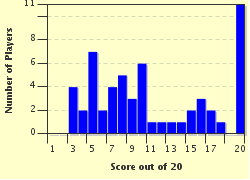Quiz Answer Key and Fun Facts
1. The British tank engines popularly known as "Terriers" were so named for which of the following reasons?
2. Of what London North Eastern locomotive class were the locomotives known as "Bongos"?
3. On which UK rail network did the locomotives known as "Spam cans" run?"
4. Initially designed for the London Midland and Scottish Railway, when were the locomotives known as "Flying Pigs" first built?
5. "Manors" were a Great Western Railway class of engines. However, which of the following was an LNER B17?
6. Which wheel arrangement do the locos nicknamed "Crabs" have?
7. "Cauliflowers" was the intriguing nickname given to a class of engine built in which North of England location?
8. Who was the designer of the "Jersey Lily", a locomotive so called because of its curvaceous lines?
9. "Pompoms" was the rather fanciful name given to a class of goods engines designed in 1901. How many were made?
10. What was the first livery colour of "Streaks"?
11. You may be able to guess why a "Black Five" mixed traffic loco was so nicknamed, but do you know how many cylinders it has?
12. The locomotives ironically known as "Tinies" are our next group. Who did they work for in wartime?
13. Why were the locomotives dubbed "Spinners" so named?
14. It ought not to be too difficult to guess why a beautiful 4-4-0 engine was called "Greyhound" by its admirers. What do you think?
15. Which London station did the engines known as "Directors" work from?
16. Some engines were named appropriately for their era. Whose "Jubilee" did those so named celebrate?
17. Which name was NOT carried by any of the GWR "Castle" class of locomotives?
18. "Coppertop" is another nickname reflecting the appearance of the engine. Which of these companies did NOT build any of them?
19. Which of the following of this class of engine was the streamlined LNER B17, otherwise known as "Sandringhams"?
20. Finally, engines named after schools. Which of the following was the name of a Southern Railways "Schools" class V?
Source: Author
balaton
This quiz was reviewed by FunTrivia editor
stedman before going online.
Any errors found in FunTrivia content are routinely corrected through our feedback system.

